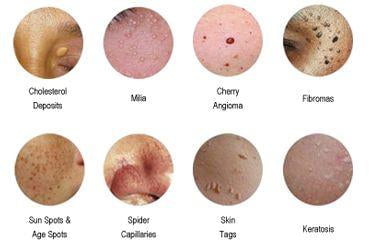Are you tired of dealing with common skin conditions such as skin tags, cherry angiomas, or milia? Look no further, as the innovative solution you need might just lie in the wonders of the Lamprobe treatment. Lamprobe is a cutting-edge device that utilizes radiofrequency technology to effectively and safely eliminate these pesky skin conditions, leaving you with a smoother and more radiant complexion. Whether it’s those tiny bumps on your face or those bothersome growths on your body, rest assured that the Lamprobe treatment is here to address your skin concerns and restore your skin’s natural beauty. Get ready to say goodbye to skin woes and hello to a clearer, healthier you!
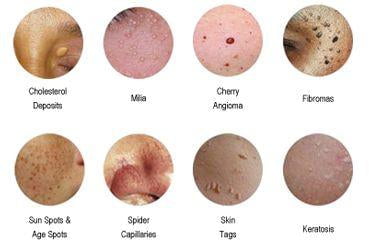
This image is property of cdn.shopify.com.
Acne-related Conditions
Whiteheads
Whiteheads, also known as closed comedones, are a common type of acne. They occur when oil, dead skin cells, and bacteria clog the pores. The blocked pore appears as a small, white bump on the surface of the skin. While whiteheads are not usually painful, they can be unsightly and affect your self-confidence.
There are various treatment options for whiteheads, including topical creams and cleansers that contain ingredients like salicylic acid and benzoyl peroxide. These products help to unclog the pores and reduce inflammation. In some cases, extraction may be necessary to remove stubborn whiteheads. Lamprobe treatment can also be effective in eliminating whiteheads by using high-frequency radio waves to target and destroy the oil-producing glands that contribute to their formation.
Blackheads
Blackheads, also known as open comedones, are another common form of acne. They occur when the pores become clogged with oil, dead skin cells, and bacteria, but unlike whiteheads, the pore remains open, causing the trapped material to oxidize and turn black. Blackheads are most often found on the nose, chin, and forehead.
To treat blackheads, it’s important to keep the skin clean and exfoliated. Using gentle cleansers and exfoliants can help remove excess oil and dead skin cells, preventing the formation of blackheads. Additionally, certain topical treatments containing retinoids or acids like salicylic acid can help unclog the pores and reduce the appearance of blackheads. In some cases, manual extraction may be necessary, and Lamprobe treatment can also be an effective option for removing blackheads.
Cystic Acne
Cystic acne is a severe form of acne characterized by large, painful, inflamed cysts that develop beneath the skin. It occurs when bacteria, oil, and dead skin cells become trapped deep within the pores, causing an infection. Cystic acne can be extremely painful and can leave behind deep scars if not properly treated.
Treating cystic acne often requires a combination of topical and oral medications. Prescription-strength retinoids, antibiotics, and hormonal treatments may be prescribed by a dermatologist to reduce inflammation and control bacterial overgrowth. In some cases, a dermatologist may also recommend drainage or injection of cysts to alleviate pain and prevent scarring. Lamprobe treatment is another option that can be used to destroy the oil-producing glands responsible for cystic acne.
Acne Scars
Acne scars are a common aftereffect of severe acne or repeated breakout episodes. These scars can be either raised or depressed, and they can have a significant impact on one’s self-esteem. Raised scars, known as hypertrophic or keloid scars, result from an overproduction of collagen during the skin’s healing process. Depressed scars, on the other hand, occur when there is a loss of tissue during the healing process.
Treating acne scars can be challenging, but there are several options available. These include laser treatments, chemical peels, microneedling, dermal fillers, and surgical excision. Lamprobe treatment can also be beneficial for improving the appearance of acne scars by targeting and reducing scar tissue through the application of radio waves.
Pigmentation Disorders
Melasma
Melasma is a common skin condition characterized by brown or gray patches on the face, most commonly on the cheeks, forehead, and upper lip. It is often triggered by hormonal changes, sun exposure, and certain medications. Melasma is more common in women, particularly those with darker skin tones.
Treating melasma typically involves a combination of topical creams, chemical peels, and laser treatments. Sun protection is crucial in managing melasma, as exposure to UV rays can worsen the condition. Topical treatments containing ingredients like hydroquinone, retinoids, and azelaic acid can help lighten the dark patches. Lamprobe treatment can also be effective in targeting and reducing the hyperpigmented areas associated with melasma.
Hyperpigmentation
Hyperpigmentation refers to dark patches or spots on the skin caused by an excess production of melanin. It can be triggered by sun exposure, hormonal changes, inflammation, and certain skin injuries. Hyperpigmentation can occur in any area of the body, including the face, hands, and legs.
Treating hyperpigmentation depends on the underlying cause and severity of the condition. Sun protection and the use of topical treatments containing ingredients like hydroquinone, retinoids, and vitamin C can help lighten hyperpigmented areas. Chemical peels, microdermabrasion, and laser treatments can also be effective in reducing the appearance of hyperpigmentation. Lamprobe treatment targets the excess melanin in the affected areas, promoting a more even skin tone.
Hypopigmentation
Hypopigmentation refers to the loss of melanin in certain areas of the skin, resulting in lighter patches. It can be caused by conditions such as vitiligo, genetic factors, or skin injuries. Hypopigmentation is more noticeable in individuals with darker skin tones.
There are limited treatment options available for hypopigmentation. Camouflage makeup can be used to mask the lighter patches and create a more even skin tone. In some cases, the use of topical corticosteroids or calcineurin inhibitors may help stimulate melanin production. Lamprobe treatment is not typically used for hypopigmentation, as it targets areas of excess pigment rather than areas with deficient pigment.
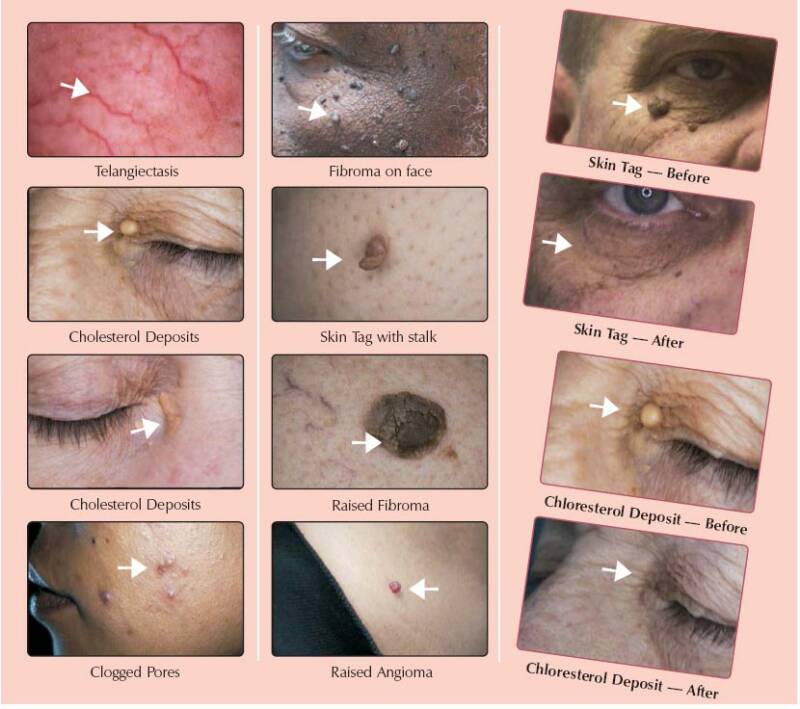
This image is property of www.pellemedicalskincare.com.
Vascular Conditions
Telangiectasia (Spider Veins)
Telangiectasia, commonly known as spider veins, are small, dilated blood vessels that appear close to the surface of the skin. They often appear as thin, red, or purple lines and can be found on the face, legs, or other areas of the body. Spider veins are typically harmless but can be a source of aesthetic concern for some individuals.
Treatment options for spider veins include sclerotherapy, laser therapy, and intense pulsed light (IPL) therapy. These treatments work by damaging or collapsing the tiny blood vessels, causing them to fade over time. Lamprobe treatment is generally not used for spider veins, as it is more effective for targeting skin imperfections rather than blood vessels.
Cherry Angiomas
Cherry angiomas are small, smooth, and bright red bumps that often appear on the trunk or limbs. These benign growths are caused by an overgrowth of blood vessels and are more commonly found in individuals over the age of 30. Cherry angiomas are generally harmless but can be a cosmetic concern for some individuals.
Treatment for cherry angiomas is not usually necessary unless the growths bleed, become painful, or cause distress. However, if desired, the growths can be removed through various methods, such as laser treatment, electrocautery, or cryotherapy. Lamprobe treatment is another option that can be used to target and eliminate cherry angiomas.
Rosacea
Rosacea is a chronic inflammatory skin condition that primarily affects the face, causing redness, flushing, and the appearance of small, red bumps known as papules. It often occurs in individuals with fair skin and can be triggered by factors such as sun exposure, stress, and certain foods or beverages.
Managing rosacea involves a combination of lifestyle changes, topical treatments, and oral medications. Avoiding triggers, such as spicy foods and alcohol, can help reduce flare-ups. Topical treatments containing ingredients like metronidazole or azelaic acid can help control inflammation and reduce redness. In some cases, oral medications like antibiotics or isotretinoin may be prescribed. While Lamprobe treatment is not typically used for rosacea, it can be beneficial for targeting associated visible blood vessels or skin irregularities.
Benign Skin Lesions
Skin Tags
Skin tags are small, flesh-colored or slightly pigmented growths that commonly appear on the neck, armpits, eyelids, and other areas where the skin rubs against itself. These benign lesions are composed of collagen fibers and blood vessels and often occur in individuals who are overweight or have a family history of skin tags.
Skin tags can be easily removed with various methods, including cryotherapy, electrosurgery, and ligation. These procedures effectively cut off the blood supply to the skin tag, causing it to fall off. Lamprobe treatment is another option for removing skin tags, as it uses high-frequency radio waves to target and destroy the tissue.
Mole Removal
Moles are common skin growths that can appear anywhere on the body. While most moles are harmless, some may develop into melanoma, a type of skin cancer. It is important to regularly monitor moles for changes in size, shape, or color and consult a dermatologist if any suspicious changes are noticed.
Mole removal is often recommended for cosmetic or diagnostic purposes. The most common method of removing moles is through surgical excision, in which the mole is cut out and the wound closed with sutures. Other methods, such as laser removal or shaving, may be used for smaller, non-cancerous moles. Lamprobe treatment is generally not used for mole removal, as it is more suitable for targeting superficial skin imperfections rather than deeper skin growths.
Fibromas
Fibromas are benign skin growths that appear as small, flesh-colored or slightly pigmented bumps on the skin. They are composed of connective tissue and can develop on any part of the body. Fibromas are typically painless and do not require treatment unless they cause discomfort or cosmetic concerns.
Removal of fibromas can be done through various methods, including surgical excision, shaving, or cryotherapy. These procedures effectively remove the fibroma from the skin. Lamprobe treatment is not commonly used for fibroma removal, as it is typically more suitable for targeting surface or superficial skin irregularities.
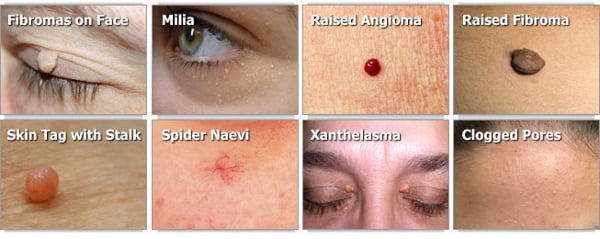
This image is property of amararejuve.com.
Warts and Viral Lesions
Common Warts
Common warts are small, rough, and raised growths that typically appear on the hands and fingers. They are caused by the human papillomavirus (HPV) and are highly contagious. Common warts are usually harmless but can be bothersome and unsightly.
Treatment options for common warts include over-the-counter topical treatments that contain salicylic acid or cryotherapy, which involves freezing the wart with liquid nitrogen. In some cases, surgical removal or laser therapy may be necessary. Lamprobe treatment is not typically used for common wart removal, as it is more effective for targeting other types of skin imperfections.
Plantar Warts
Plantar warts are similar to common warts but occur on the soles of the feet. They can be painful, especially when walking or standing, as the pressure from body weight can cause them to grow inward. Plantar warts are also caused by the human papillomavirus (HPV) and are highly contagious.
Treating plantar warts can be challenging due to their location and the pressure applied to the soles of the feet. Over-the-counter treatments containing salicylic acid can be effective in softening the wart and promoting its removal. In some cases, cryotherapy or laser therapy may be recommended. Lamprobe treatment is generally not used for plantar wart removal, as it is more effective for superficial skin irregularities.
Molluscum Contagiosum
Molluscum contagiosum is a common viral skin infection that results in small, flesh-colored or pink bumps on the skin. It is caused by the molluscum contagiosum virus (MCV) and is highly contagious, particularly in children. Molluscum contagiosum is usually harmless and self-limiting, resolving without treatment within a few months to a few years.
In some cases, treatment may be recommended to prevent the infection from spreading or to alleviate symptoms. Treatment options include cryotherapy, curettage, or topical medications like imiquimod. Lamprobe treatment is generally not used for molluscum contagiosum, as it targets skin irregularities rather than viral infections.
Sebaceous Hyperplasia
Treatment Procedure
Sebaceous hyperplasia is a common benign condition characterized by yellow or flesh-colored bumps on the face. It occurs when the sebaceous glands become enlarged and produce excess sebum. Sebaceous hyperplasia is more commonly seen in individuals with oily skin or those who have a history of sun exposure.
Lamprobe treatment can be an effective option for treating sebaceous hyperplasia. The procedure involves using high-frequency radio waves to target and destroy the enlarged sebaceous glands. The treatment is relatively quick and generally well-tolerated, with minimal discomfort and downtime.
Benefits of Lamprobe for Sebaceous Hyperplasia
Lamprobe treatment offers several benefits for the treatment of sebaceous hyperplasia. Firstly, it provides precise targeting of the affected sebaceous glands, resulting in more focused treatment and minimal damage to the surrounding skin. Additionally, Lamprobe treatment is non-invasive, meaning there are no incisions or injections involved. The treatment is also relatively quick, with each session typically lasting only a few minutes.
After treatment, it is normal to experience some redness or mild swelling, which usually subsides within a few days. The results of Lamprobe treatment for sebaceous hyperplasia can be long-lasting, with many individuals experiencing significant improvement in the appearance of their skin.
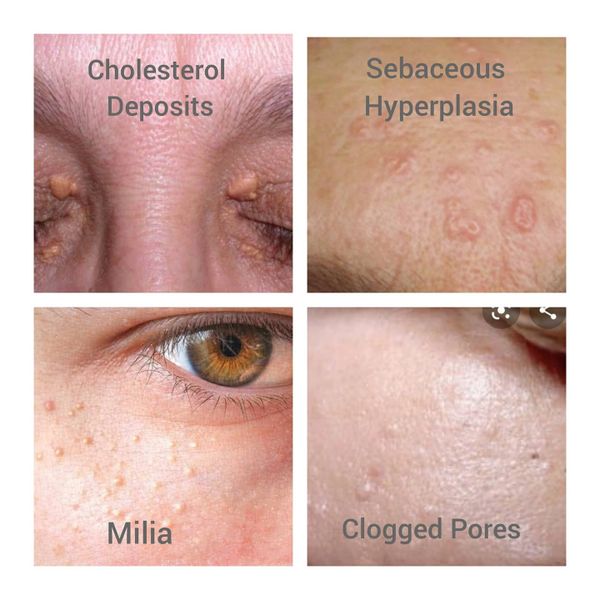
This image is property of img1.wsimg.com.
Milia
Overview of Milia
Milia are small, white or yellowish bumps that commonly appear on the face, particularly around the eyes and cheeks. They are caused by the buildup of keratin trapped beneath the surface of the skin. Milia are most often seen in newborns but can also occur in adults, especially those with dry or damaged skin.
Lamprobe treatment can be an effective option for removing milia. During the procedure, high-frequency radio waves are used to target and break down the keratin-filled cysts that form milia. The treatment is minimally invasive and typically well-tolerated, with little to no downtime.
Lamprobe Treatment for Milia
Lamprobe treatment offers several advantages for the removal of milia. It provides precise targeting of the milia, allowing for effective treatment without damaging the surrounding skin. The procedure is relatively quick and can be performed in a dermatologist’s office. After treatment, it is normal to experience some mild redness or swelling, which typically resolves within a few days.
The results of Lamprobe treatment for milia can be noticeable immediately, with milia either being completely removed or significantly reduced in size. With proper skincare and maintenance, the recurrence of milia can be minimized, resulting in smoother and more even-looking skin.
Cholesterol Deposits
Causes and Appearance
Cholesterol deposits, also known as xanthelasma, are yellowish, fatty bumps that commonly appear on the eyelids. They are caused by the accumulation of cholesterol beneath the skin’s surface and are often associated with high cholesterol levels. Cholesterol deposits can vary in size and shape, and they can be cosmetically concerning for some individuals.
Removing Cholesterol Deposits with Lamprobe Lamprobe treatment can be a highly effective option for removing cholesterol deposits. The procedure involves using high-frequency radio waves to target and break down the fatty deposits. The treatment is relatively quick and generally well-tolerated, with minimal discomfort and downtime.
After treatment, it is normal to experience some mild redness or swelling, which usually subsides within a few days. The results of Lamprobe treatment for cholesterol deposits can be significant, with the deposits either being completely removed or significantly reduced in size. With proper maintenance, the recurrence of cholesterol deposits can be minimized, resulting in a smoother and more youthful appearance.
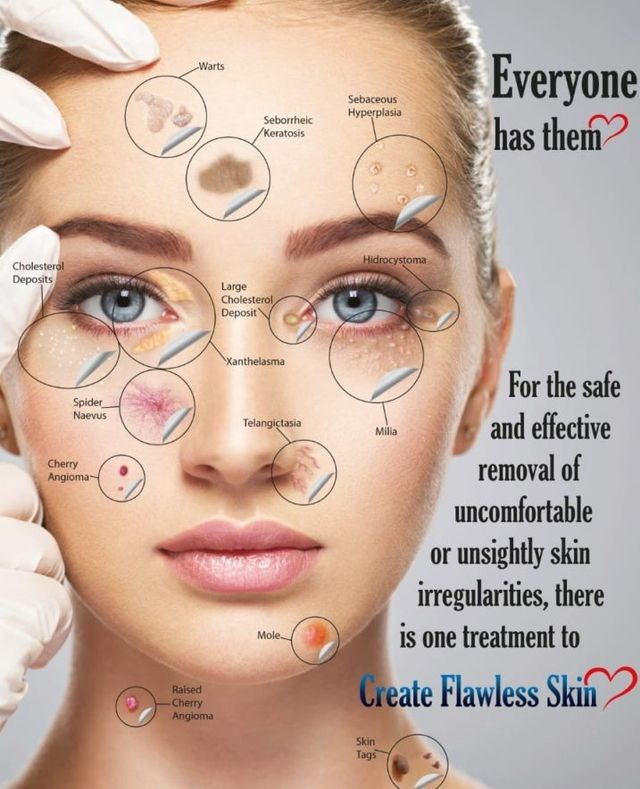
This image is property of lirp.cdn-website.com.
Seborrheic Keratosis
Understanding Seborrheic Keratosis
Seborrheic keratosis is a common benign skin growth that appears as a brown, black, or tan wart-like lesion. It often has a waxy, stuck-on appearance and can vary in size and shape. Seborrheic keratosis is most commonly seen in older individuals and is typically harmless, although it can be cosmetically bothersome.
Lamprobe Treatment for Seborrheic Keratosis Lamprobe treatment can be an effective option for treating seborrheic keratosis. The procedure involves using high-frequency radio waves to target and remove the lesion. With precise targeting, Lamprobe treatment can effectively destroy the abnormal cells within the seborrheic keratosis, resulting in the gradual fading and removal of the lesion.
The treatment is relatively quick and typically well-tolerated, with minimal discomfort and downtime. Some mild redness or scabbing may occur following the treatment, but this is temporary and should subside within a few days. The results of Lamprobe treatment for seborrheic keratosis can be significant, with the lesion being either completely removed or significantly reduced in size and prominence.
Syringomas
Overview of Syringomas
Syringomas are small, flesh-colored or yellowish bumps that often appear around the eyes, cheeks, and forehead. They are caused by the overgrowth of sweat gland ducts and are more commonly seen in women. Syringomas are typically harmless but can be a source of cosmetic concern for some individuals.
Treating Syringomas with Lamprobe Lamprobe treatment can be an effective option for treating syringomas. The procedure involves using high-frequency radio waves to target and break down the sweat gland ducts that form the syringomas. The treatment is relatively quick and generally well-tolerated, with minimal discomfort and downtime.
After treatment, it is normal to experience some mild redness or swelling, which usually subsides within a few days. The results of Lamprobe treatment for syringomas can be significant, with the bumps either being completely removed or significantly reduced in size and prominence. With proper skincare and maintenance, the recurrence of syringomas can be minimized, resulting in a smoother and more even-looking complexion.
In conclusion, Lamprobe treatment offers a versatile solution for addressing a wide range of common skin conditions. From acne-related conditions to pigmentation disorders, vascular conditions, benign skin lesions, warts, and viral lesions, Lamprobe treatment provides targeted and effective results. Whether you are dealing with whiteheads, melasma, spider veins, skin tags, or syringomas, Lamprobe treatment can be a valuable option in the pursuit of healthier, clearer, and more radiant skin. Consult with a dermatologist to determine if Lamprobe treatment is right for you and to develop a personalized treatment plan tailored to your specific needs and concerns. Remember, with the help of Lamprobe treatment, you can achieve the beautiful, blemish-free skin you’ve always desired.

